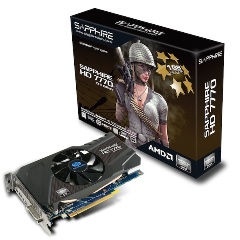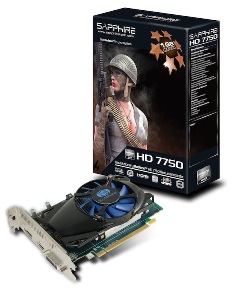
SAPPHIRE Technology ha introdotto una intera nuova serie di schede grafiche basate sulla rivoluzionaria architettura grafica GCN (Graphics Core Next) di AMD.
La nuova serie SAPPHIRE HD7700 è una famiglia di schede grafiche destinate agli appassionati attenti al budget e agli utenti mainstream che cercano una migliore prestazione grafica. Basata sulla seconda famiglia di GPU AMD costruite con processo a 28nm, le SAPPHIRE HD7770 e HD7750 condividono numerose delle funzioni delle HD7900, ma con minori Stream processors e memoria DDR5 con interfaccia a 128-bit.
Al lancio SAPPHIRE presenta la serie HD7770 con due modelli: la HD7770 GHz Edition è la prima scheda grafica mainstream fornita con core clock a 1GHz, è equipaggiata con 1GB di memoria DDR5 a 1125 MHz (5 GHz effettivi), mentre la HD7770 GHz OC Edition è overcloccata di fabbrica a 1150 MHz core e a 1250 MHz per la memoria (5 GHz effettivi). Entrambe I modelli sono dotati di sistema di raffreddamento ad alta efficenza originale SAPPHIRE a singola ventola con heatpipes.
Pensata per gli utenti più attenti al budget, la SAPPHIRE HD7750 condivide tutte le funzioni della versione HD7770, ad eccezione della velocità di core clock a 800 MHz, alla diversa configurazione di uscite e ad un minor numero di stream processors. La scheda dispone di 1GB di memoria con velocità di clock di 1125MHz (4,5 GHz effettivi), raffreddamento a singola ventola con heatpipe e rappresenta al momento la scheda più performante della serie HD7000 che non necessiti di alimentazione supplementare esterna.
Per gli appassionati che desiderano massimizzare le prestazioni, una nuova versione del tool di overclocking SAPPHIRE TRIXX è a supporto di questa ultima generazione di tecnologia, disponibile a brevissimo per il download gratuito dal sito web SAPPHIRE. TRIXX permette la regolazione della tensione della GPU, così come del core clock e della memoria, monitorando contemporaneamente la temperatura di esercizio; è possibile inoltre controllare manualmente la velocità della ventola, memorizzare profili creati dagli utenti salvando fino a quattro livelli di prestazioni diverse.
La serie HD7000 è la terza generazione di soluzioni AMD compatibile DirectX 11 ed è inoltre predisposta per le nuove DirectX 11.1 e il nuovo sistema operativo Windows 8. La comunicazione con il PC è ottimizzata con l'implementazione dell’interfaccia PCI-Express Gen3.0.
In considerazione del fatto che il lavoro o il gaming su più monitor è sempre più diffuso tra gli utenti, la serie SAPPHIRE HD7700 offre ora il supporto di questa modalità con la seconda generazione di AMD Eyefinity. Grazie alle uscite Dual-link DVI, HDMI e alle due uscite mini-DisplayPort, i modelli della serie HD7770 supportano configurazioni comprendenti fino a 6 monitor. La scheda HD7750 dispone di uscite Dual link DVI, HDMI e una singola uscita DisplayPort, per il supporto fino a quattro monitor; la gamma SAPPHIRE HD7000 offre inoltre l'output multiplo di stream audio indipendenti che consentono l'associazione dei contenuti audio corretti alle diverse applicazioni su monitor differenti.
La nuova interfaccia HDMI 1.4a supporta la visualizzazione 3D stereoscopica con frame rate portato a 60 Hz per occhio – per un totale totale di 120Hz ed è predisposta anche per la prossima generazione di display 4K, che possono essere gestiti da un unico ingresso ad alta velocità HDMI 1.4a a 3 GHz e DisplayPort 1.2 HBR2.
"APP Acceleration" è il nome dato ai tools di ottimizzazione delle prestazioni di una ampia gamma di applicazioni per sfruttare al massimo le funzionalità di stream processing e le specifiche di hardware della nuova architettura grafica. Le applicazioni tipiche includono encoding e decoding video, compressione e multiplazione per distribuzione di media, attività di gaming e videoconferenza; l’"APP Acceleration" migliora inoltre le attività più comuni come la navigazione Internet, le applicazioni Office e la compressione dei file con le suite di software supportati.

[Immagine ad alta risoluzione]

[Immagine ad alta risoluzione]

SAPPHIRE Technology has just introduced an entirely new series of affordable graphics cards based on the revolutionary new graphics GCN (Graphics Core Next) architecture from AMD. The new SAPPHIRE HD 7700 series is a new family of graphics cards targeting the enthusiast on a budget and mainstream users looking for increased graphics performance.
It is based on the second family of GPU’s from AMD built in its new 28nm process and featuring the highly acclaimed GCN graphics processing architecture. The new HD 7770 and HD 7750 GPUs have an optimised internal structure sharing many of the features of the high performance HD 7900 series already released but with fewer Stream processors and a simplified 128-bit high speed memory interface to the latest DDR5 memory types.
Two models of the HD 7770 are being introduced by SAPPHIRE at launch. The SAPPHIRE HD 7770 is the first mainstream production graphics card to ship with a core clock speed of 1GHz, and will be known as the SAPPHIRE HD 7770 GHz Edition. It is equipped with 1GB of the latest DDR5 memory clocked at 1125MHz (4.5 Gb/s effective). At the same time SAPPHIRE is introducing a high performance model, the SAPPHIRE HD 7770 GHz OC Edition, which is factory overclocked to 1150 MHz core and 1250MHz memory (5Gb/s effective). Both models have a highly efficient SAPPHIRE original single fan heatpipe cooler.
For the more budget conscious, the third model in the series is the SAPPHIRE HD 7750, which shares all the features of the HD 7770 version except that it ships with the lower core clocks of 800MHz and different output configuration as well as a lower Stream processor count. It has 1GB of memory clocked at 1125MHz (4.5 GB/s effective), and a single fan heatpipe cooler.
For enthusiasts wishing to maximise performance, a new version of the SAPPHIRE overclocking tool, TriXX supporting this latest generation of technology is available free to download from the SAPPHIRE website. TriXX allows tuning of GPU voltage as well as core and memory clocks, whilst continuously displaying temperature. Manual control of fan speed is supported, as well as user created fan profiles and the ability to save up to four different performance settings.
The HD 7000 series is the third generation of DirectX 11 compatible solutions from the graphics division of AMD - formerly ATI. The new SAPPHIRE HD 7700 series is ready for DirectX 11.1 and the new Windows 8 operating system as well as delivering all the features of the current DirectX 11 such as DirectCompute11 and multi threaded communications with the CPU. Communication with the host PC is optimised with the implementation of the latest high speed PCI-Express Gen3.0 interface, and multiple cards can be used to further enhance performance in CrossFireX mode on a suitably specified mainboard.
Working or gaming with multiple monitors is becoming increasingly popular, and the SAPPHIRE HD 7700 series supports this with AMD Eyefinity, now in its second generation. With Dual-link DVI, HDMI and two mini-DisplayPort outputs, the HD 7770 models can support configurations of up to 6 monitors. The HD 7750 has Dual link DVI, HDMI and a single DisplayPort output, supporting up to four monitors. In addition, the SAPPHIRE HD 7700 series cards can simultaneously output multiple, independent audio streams allowing the correct audio content to be associated with different applications on different screens.
HDMI specifications have also increased in the HD 7000 series. Fast HDMI 1.4a supports Stereoscopic 3D with enhanced frame rates of 60Hz per eye - 120Hz total. It is also ready for the next generation of 4K displays that can be driven from a single high speed input of 3GHz HDMI 1.4a or DisplayPort 1.2 HBR2.
APP Acceleration is the name given to the enhanced performance of a wide range of applications using the stream processing capabilities and specific hardware features of the graphics architecture. The HD 7000 series has been optimised for this type of task. Typical applications include Video encoding and decoding, compression and multiplexing for media distribution, gaming or video conferencing. APP acceleration can also enhance everyday tasks such as Internet browsing, Office applications and file compression with supported software suites.
The SAPPHIRE HD 7700 series products are now available through SAPPHIRE’s established channel and etail partners.
News Source: AMD Press Release
Links
|